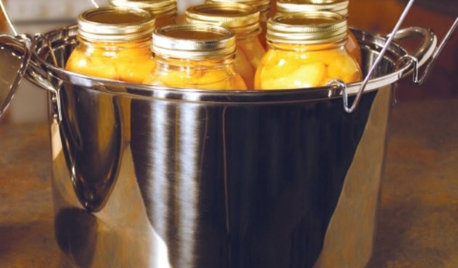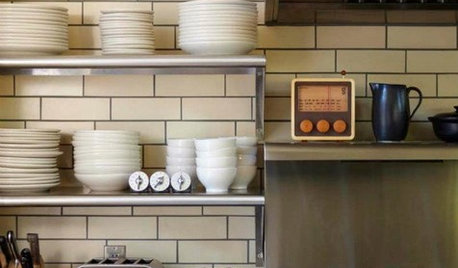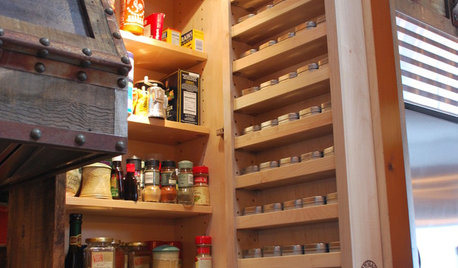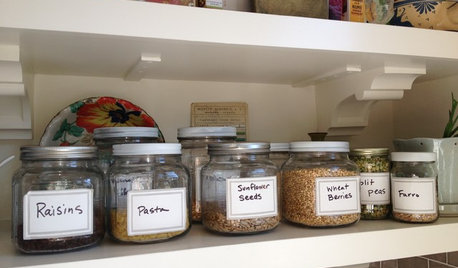corn canning compound
I have heard about a compound made by the druggist for use in canning corn. It makes the corn taste like fresh corn. Has anyone heard of this and if so will they share the recipe. I canned corn last year using lemon juice in the corn and it was good but this sounds better.
Comments (34)
gran2
17 years agonever heard of such a thing. Could it be something like citric acid? I would be very wary of most other things. Can't quite imagine what something like citric acid would do anyway. I think the best way to have good tasting corn is to get it in the jars as soon as possible. We have a four-hour limit here, from garden to jars. Every hour that corn spends off the stalk, the sugars are turning to starches and toxins are developing. Just be fast. Keep us posted.
ksrogers
17 years agoIts probably ascorbic acid as the corn can darken when canned. I just blanch the ears, cut them from the cobs and freeze. Its a far fresher taste that way than to can them.
Related Professionals
La Marque Landscape Architects & Landscape Designers · Beachwood Landscape Contractors · Belmont Landscape Contractors · Clayton Landscape Contractors · Conroe Landscape Contractors · North Canton Landscape Contractors · Salem Landscape Contractors · Eastlake Landscape Contractors · Albany Roofing & Gutters · Oklahoma City Roofing & Gutters · Red Bank Roofing & Gutters · La Jolla Roofing & Gutters · West Orange Roofing & Gutters · Colonia Roofing & Gutters · Ocala Driveway Installation & MaintenanceLinda_Lou
17 years agoYes, I agree, it was most likely ascorbic acid. You can use Fruit Fresh, that is what is in it. It in normally used for canning fruits, not vegetables. That, or vitamin c tablets are used for fruits. Never heard of using it in corn.
Ascorbic acid is used to prevent browing in fruits, citric acid raises the acid level, and is used in canning tomatoes.ksrogers
17 years agoAscorbic acid will not significaly raise the acid level as its not as acidic as citric acid would be. I made some corn relish a few years ago and the tops of the contents had discolored after a while, and appeared to be due to the lack of something to help keep them from oxidizing, as the liquid level was a bit less, so it didn't cover all the corn.
cando_1
17 years agoHi, Corn canning compound is known as corn canning acid. It is a preservative made of salicylic acid and sodium sulfite. It does improve taste and the keeping of the corn. It is also used on corn, peas and green beans using the recipe below:
Corn(With Canning Acid)
l bottle corn canning acid
1/2 cup salt(I use 4 to 6 T. canning salt)
2 cups sugar(Can omit or increase to 3 cups)
3 quarts water
20 quart sweet corn(cut off the cob-use scant qts to measure)Mix canning acid, salt, sugar and water. Mix with corn well. Pack into clean jars, leave l inch headspace. Divide liquid mixture among filled jars, then fill rest of the way with water, leaving l inch headspace. Wipe jar rims. Seal and process by one of the methods below:
Water Bath: 3 hours(pints or quarts)
Pressure Canner: 30-40 minutes at 10-11 pounds pressure(pints and quarts)
This will can 20 quarts or 40 pints.The acid is available from Mast's Pharmacy in Ohio by calling 1-330-893-3179 or from E and R Seed,1356 E. 200 S., Monroe In 46772. it is used in Old Order Amish and Mennonite communities. I also can my corn as follows:
To each quart jar add: l T. Realemon,
l tsp. canning salt
l tsp. sugar
Water to fill jar
Leave l Inch headpace. Wipe rims, seal and water bath 3 hours or in pressure cannner 20 min. pints, 30 minutes, qts at 10-11 pounds pressure. It keeps well. I have used this method for 2o years with no spoilage. It is not dark as cor done by USDA time of 55 min, pts and 85 min, qts. These recipes and others are in my canning book"Country Canning" Hope this helps, James R. Coffeyreadinglady
17 years agoIf you have the space, I think freezing definitely does result in the best product for corn. I personally would not feel comfortable processing corn for less than the recommended time. It is one of the highest-risk vegetables.
Aside from making sure the product is as fresh as possible, there are some other things to keep in mind if you want to avoid browning, etc. when canning. "Super-Sweet" varieties are more likely to brown, so pick a variety suitable for canning. Also, make sure the corn is fully ripe. Immature corn will brown. Minerals in the water can also be a factor in the color of the finished product.
Carol
ksrogers
17 years agoThe only way I would can corn would be as a relish with vinegar. Blanch the ears, cut off the kernals and freeze. This is the best way to enjoy it and takes up far less freezer space. According to the comments about the canning acid, sulfur is available from several wine making supply houes. The salisylic acid is similar to an asprin.. Its primarily used to reduce oxidation after canning. Ascorbic acid can do almost the same thing. I dip raw, sliced, peeled potatoes in a solution of sodium metabisulfate to prevent them from blackening when drying.
Linda_Lou
17 years agoBoiling water bath for corn is totally unsafe. Sorry, but that puts a person at a risk for botulism. It takes the temperatures of a pressure canner to destroy botulism spores. You can boil water forever and never reach any temp. higher than 212. You need to process for the full time in a steam pressure canner to prevent botulism.
The book Country Canning sounds totally unsafe to me to follow. Many well meaning people write canning books that have no training in food safety and should not be followed.Why must low acid foods be processed under pressure?
Temperature of boiling water is 212 degrees; at that temperature it is very difficult to destroy the Clostridium botulinum spores, even by lengthy processing. Clostridium botulinum thrives in a low acid food in a vacuum (without air) and produces a toxin which can cause botulism. A combination of time and temperature is recommended which will destroy the organism and keep the product safe. This necessary temperature cannot be reached in a boiling water bath; however, a steam pressure canner can reach temperatures higher than 212 degrees F.
Barbara Willenberg, Nutritional Sciences, University of Missouri-Columbia.
It takes 85 min. in a pressure canner for corn. The 30- 40 min. will not be long enough to destroy the botulism spores.
ksrogers
17 years agoHope you realize that I was only referring to a vinegar based corn relish. No water was added, only salt, sugar, mustard seeds ground up, onion and well cooked corn prior to cooking with the vinegar.
Linda_Lou
17 years agoKen, it was about the post on canning plain corn in a BWB canner from the previous post, not yours.
ksrogers
17 years agoOk.. as you know that 'magical' stuff (vinegar) can do wonders for those who lack a pressure canner..
malonanddonna
17 years agoYou can boil water forever and never reach any temp.
That's not true and I can prove it.The book Country Canning sounds totally unsafe to me to follow.
Wow, the entire book? Not just one recipe. I'd have to actually have to read the book to make a judgement call like that.ksrogers
17 years agoAnd then comes that infamous steam canner, but we should not go into that again, just wanted to point out that there are a few of us out there that hate a hot steamy kitchen for canning and sometimes use processing methods that don't even involve heat.
malonanddonna
17 years agoJames - Thanks for the clarification on your book. Unfortunately, there are those that believe they can only do what the USDA says, no matter what. It doesn't matter what was done in the past or what may be done in other countries. If the USDA hasn't tested it and placed their rubber stamp of approval on it, they feel it is "totally unsafe".
I don't water bath my low-acid foods - I prefer the shorter times used in a pressure canner. But like Ken, I use a steam canner for high acid foods (like was done in years past) instead of a BWB. We should all have the freedom to do as we please.
ksrogers
17 years agoMy 10 jars of sweet cucumber pickles, both whole and crinkle cut slices are now out of the steam canner. The kitchen heated up more with the boiling vinegar brine, compared to what the steam canner put out. I am still amazed at how sweet the brine can get with just a small amount of Splenda that I add to the brine. This batch had fresh dill seed heads and the weed, a few celery seeds and mustard seeds, a single peppercorn per jar and some fresh garlic, along with a little dried sweet red and green pepper flakes for a hint of color.
Blake_pickyourown_org
16 years agoOld myths seem to die slowly. Salicylic acid (aspirin) as a home canning preserving agent is not considered safe by any reputable authority I know (I can provide innumerable references for those interested). As a flavor enhancer, it's status would be equally dubious, as there are also plenty of cases of allergic reactions to it. For best flavor, corn should be blanched, vacuum packed and frozen. See this page for illustrated directions http://www.pickyourown.org/freezingcorn.htm or this page to freeze whole ears: http://www.pickyourown.org/freezingcornonthecob.htm. Raw pack canned corn may retain texture and flavor a bit better than hot pack: Canning directions are on this page: http://www.pickyourown.org/howtocancornrawpack.htm. And don't forget that storing the jars in a cool, dark environment helps to preserve flavor.
Here is a link that might be useful: how to can corn at home
Wilma Wiggins
9 years agoI have been searching for canning methods from the WWII years when the government wanted people to can. I suspected their advice would differ from today's, that seems bent on getting people not to can. I have followed the safe recommendations and the results have been overcooked, mushy, unpleasant results. I hear the story about "changing times", etc. but most of it is unconvincing. Except for tomatoes being less acid, most food is about the same as it was. Do we know how safe it was in the '40's? I don't but I suspect most people lived through it. I wish I had as much faith in the gov'mint as some of you but really, I don't have much.
readinglady
9 years agoMy 1948 Kerr canning book says processing time for corn is 55 minutes pints and 85 minutes quarts at 10 psi. Current standards for processing corn are 55 minutes pints and 85 minutes quarts at 10 psi. No difference at all.
So while it is true some canning practices have changed (largely due to more sophisticated testing methods), many have not.
Do keep in mind also that in the 1940's it was recommended to boil all canned meats and vegetables in an open vessel for 10-15 minutes before consuming, so that even when processing times were shorter there was a fail-safe designed to neutralize any potential toxins. That is no longer necessary if current recommendations are followed. Having consumed my share of "old-style" overcooked vegetables, I would argue that modern methods can yield superior results.
A search online will yield many historical canning facts or old canning books can be purchased on auction sites (though I would caution against using them with low-acid product).
Carol
Wilma Wiggins
9 years agoCarol, that would be 3 years after the war was over so maybe they were already discouraging home canning by then? At least no longer advocating it. Yes that thing about boiling vegetables and meats 10-15 minutes did prevent some poisoning, I'm sure. Do you think modern methods result in less overcooked vegetables? What I don't understand is how commercial canners can end of with whole tender cooked dry beans for example, but when following current directions, they are way overdone, mushy and split. I question if it is really necessary to pressure cook them for 75 minutes in pint jars.
balloonflower
9 years agoWilma,
I have a copy of a WWII Kerr canning booklet that was recently given to me when a great-aunt passed. I do not know which specific year, as I believe the outer cover only is missing, but the graphics are housewives in aprons saluting, a page on Victory Gardens, the notices about discontinuation of jar manufacturing, etc. it's really fun to look through, but some things make me cringe. 240 min BWB for canned fish! Really, I can't imagine keeping the canner boiling for that long. If you email me (however possible with Houzz), I would be happy to send you some page photos.
Commercial canning methods cannot be compared to home canning--their equipment has way different capabilities, pressures, and temps than we can replicate. I'm just getting started with canning veg, and so far it is overcooked to my taste. Even the shred pork I recently tried I wasn't happy with the flavor. I will stick to freezer for much, although it's somewhat moot for me, as I don't quite grow enough that doesn't get immediately eaten because we take up most of our community garden plot with maters for sauce and salsa. But I love having the option and am thankful for new regulations that bring the safety current. Personally, I would hazard a guess that our immune systems are not nearly as hardy anymore, and how many deaths that were somewhat caused or hastened by food borne illness were attributed to other cause? You can do what you want for yourself and home, but to advise anyone else to take that risk without also fully explaining the safety issues is irresponsible in my opinion. (I am referencing earlier posts--not criticizing your very honest question).
readinglady
9 years agoI do know when WWII ended. Trust me; canning methods and recommendations did not morph into something totally different in three years.
There is a big difference between "discouraging" canning and not actively promoting. Certainly the highly visible promotion of victory gardens, home canning and rationing ended, but research and education continued through the network of extension services, and canning culture remained a significant element of rural life.
But society changed. By the 70's more and more women were entering the workforce and the emphasis in food moved from "slow" to convenience and speed. Add the increasing urbanization of society and the move away from family farms and you have a new generation largely unfamiliar with home food preservation.
To get back to the issue, many foods are simply better frozen than canned; that's as true for commercial products as it is for home. As far as canned foods and "mushiness" is concerned, you can alleviate that problem in large part by using a firming agent just as the big companies do. It's calcium carbonate marketed by Ball as Pickle Crisp. It's just that many people are not aware that it's not limited to pickles.
The home canner will always be at a certain disadvantage compared to commercial processors as they have access to industrial pressure canners, testing labs and (sometimes) additives which may yield a crisper more colorful product.
The advantage of home canning is that you control the product from field to jar. It is not necessarily, however, the most economical choice, and if you honestly prefer the commercial product, watch for sales and buy that. I am not being snarky. There have been lengthy discussions on this forum about the cost effectiveness of home canning and which products might be better purchased (Tomato paste comes to mind.)
Canning often reflects values other than economy.
As far as the recommendation to can fish for 240 minutes is concerned, during WWII, recognizing that many did not have access to pressure canners, the government provided alternative BWB times. But pressure canning was the preferred safest choice for low-acid product and had been since WWI.
We often say here that we are not the canning police and individuals must decide for themselves how they intend to approach home canning and any potential risk. As the previous poster noted, things today are not as they were 70 years ago. Bacteria have evolved. A greater number of medically fragile and vulnerable survive in the general population. Testing mechanisms are also more sophisticated and have identified risks earlier generations were not cognizant of. For those reasons most of us prefer to follow current guidelines. Personally I am not comfortable recommending otherwise for high-risk product.
Old canning books are great for sweet preserves. But for green beans I use the most up-to-date.
Caroldigdirt2
9 years agolast modified: 9 years ago<Do you think modern methods result in less overcooked vegetables? What I don't understand is how commercial canners can end of with whole tender cooked dry beans for example, but when following current directions, they are way overdone, mushy and split.>
Yes I do. When they are properly done. Far too often we blame the canning guidelines for the end result when in fact it was the methods we used or the quality of the food before it was put into the jar that is the cause.
I can make "whole tender cooked" dry beans just like commercially canned ones and I'm sure others can as well. I use high quality fresh harvested beans to begin with rather than plastic bags of them that were picked months or years ago and stored who knows how, I use the quick rehydrate method, I remove the pot from the heat rather than over-boiling them before filling the jars (many leave them boiling while filling jars), by not over-packing the jars as many do, by not taking forever to get the PC up to pressure or letting them process at an overly high pressure as many do for convenience, and by not leaving the jars sitting in the canner as many do after proper cool down.
We all adopt short-cut methods, often without being aware of it and never give a thought to how those methods affect the food. It is so much easier to just blame the quality on the government guidelines. Plus when it comes to pressure canning it amazes me how many do it without really understanding how it works.
We all decide our own level of acceptable risk but we need to include our own short-comings in that decision making rather than laying it off on the government. :)
Dave
Wilma Wiggins
9 years agoDave that is excellent news. Maybe you can help me? I live at 3000 ft elevation so use 15 lb pressure (weighted pc). According to what I have read, dry beans need to be processed for 75 min in pint jars. That has not worked out well for me. Too overdone. Maybe my pc took too long to get up to pressure, but not because I wanted to. Maybe I should have the water in it boiling before I add the jars? Last time I used dry beans, not soaked at all, and covered them with cold water with a bit of salt. (Unsafe cheating?) I filled less than half full of beans. It turned out there were too many beans, not enough liquid to cover, and the beans were still somewhat mushy although not as bad as when I pre-soaked them. Maybe I should use Pickle Crisp? Any help would be much appreciated. The only thing is I have to use the plastic bags of beans I have on hand, and not sure where to even get the fresh ones of which you speak.
digdirt2
9 years agolast modified: 9 years agoYou have 2 strikes against you Wilma - your altitude and having to use packaged beans. The altitude I can't help with except to suggest a dial gauge canner so that you'd only have to use 12 lbs. 15 lbs. will mush many things that do well down at my altitude and 10 lbs. so a dial gauge lets you be more flexible with the pressure used. Of course you have to have the gauge checked for accuracy. But that is a good example of how it isn't the guidelines that are the cause of the problem. :)
The bean quality makes worlds of difference - if you can't grow your own as I do and as commercial canners use (fresh harvested) - can be improved by changing sources for your dried beans. Do you have anything like a Whole Foods store or similar available? Stores where the stock is dated and turns over quickly and sold in bulk? The bags sold in the grocery stores for $1.50, $1.95 and such are already months old (years in some cases) and were often dried artificially and overly dried.
<Last time I used dry beans, not soaked at all, and covered them with cold water with a bit of salt. (Unsafe cheating?) I filled less than half full of beans. It turned out there were too many beans, not enough liquid to cover, >
Yeah that would be considered unsafe due to insufficient heat penetration. And the low liquid in the jars will definitely happen if they aren't at least somewhat rehydrated first as they will soak it all right up. You could try the overnight soak in very hot water (no stove heat just pour boiling water over them and then let them sit) and then next day just heat them up to boiling, fill the jars 1/2 to 2/3 full with the rehydrated hot beans and top with HOT water and salt. The jars and contents need to be hot going into the PC.
And yes you can use Pickle Crisp too. I use it with my canned potatoes and it really helps.
One other suggestion is doing them in tomato juice rather than water. Requires only 65 mins for pints and they stay firmer as the juice isn't as readily absorbed. The instructions say tomato sauce but I prefer using juice.
Hope this helps.
Dave
Wilma Wiggins
9 years agoThank you for your suggestions. I wonder how necessary that extra 2 lbs of pressure really is, maybe I could get away with 10 lb pressure? When I took those jars out of the canner, the liquid in them was boiling away for quite some time before they cooled. Do you think they are unsafe to eat now or do you think the extra pressure made up for it? So you probably hit the nail on the head why I've had such poor results - who would have thought 5 lbs of pressure could make so much difference?
readinglady
9 years agoThere are a number of previous threads about canning dry beans which provide all sorts of tips to make the process more fool-proof in terms of consistently yielding a high-quality product. I think most of us would agree that dried beans are one of the most challenging home-canned items and every little bit of advice helps. I'd recommend searching for some of those old threads and then coming back with any additional questions after reading.
Carol
readinglady
9 years agoIf forums permitted cursing that's what I would be doing. I thought the old Gardenweb had a horrible search function but Houzz has made it even worse. And now even Google advanced search doesn't yield what I want. I finally figured out some work-arounds and am going to try to post multiple links in this message. But again, there's no preview function, so I can only hope. These old threads offer advice on such topics as liquid loss in jars and amount of pickle crisp to use for firmer beans. I hope this helps.
Carol
http://forums.gardenweb.com/discussions/1928431/how-to-can-garbanzo-beans-chickpeas?n=22
http://forums.gardenweb.com/forums/load/harvest/msg101611571110.html
http://forums.gardenweb.com/discussions/1959456/confused-about-canning-dried-beans?n=4
http://forums.gardenweb.com/forums/load/harvest/msg090114053268.html
digdirt2
9 years ago
Canning beans discussions
Here are all the Harvest forums discussions on canning beans. To search just go to the search bar top of each page and type in your term. A drop down menu appears - click on "in Harvest forum".Dave
readinglady
9 years agoThank you Dave. How crazy. I tried searching using the bar and didn't get the Harvest option at all, just GardenWeb as a whole. Now, though, it is working for me. Either way there's clearly a lot of good info archived on the forum already.
Carol
Wilma Wiggins
9 years agoCarol, thanks a bunch for your help. I think I am set now in time to do my chickpeas.
Deb Schuldt
7 years agolast modified: 7 years agoThis is what I use.
You need 16 ounces of Salicylic Acid
4 ounces of Sodium Sulfite A.C.S. 98% pure.
Mix these in a jar big enough to shake the living daylight out of it. (SHAKE OFTEN)
Heres recipe
2 gallons of freshly cut and milked corn
4 level Tablespoons of canning salt
1 cup of sugar
1 Tablespoon plus 1 teaspoon of corn canning compound
1 quart of water
Mix well.let set 5 minutes stir well again. Put in jars(not too tightly)
Add water to cover corn if needed. Get out air bubbles.
Put in pressure canner at 10# for 55 minutes.
WaLa best dang canned corn you will ever eat.
















jrc_21921_yahoo_co_uk